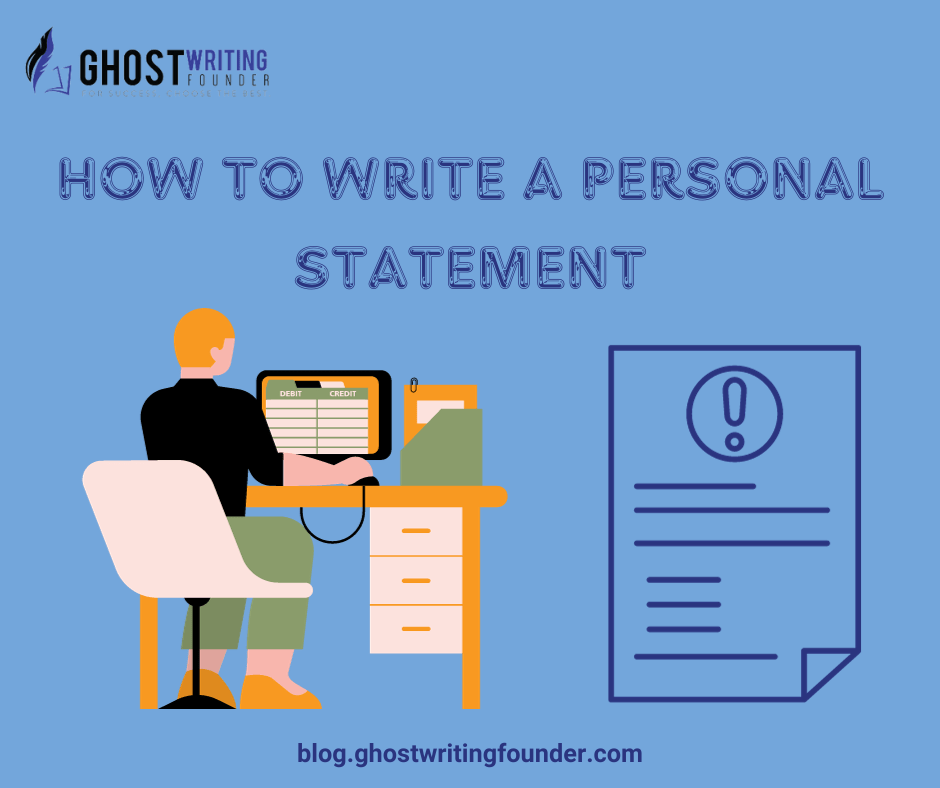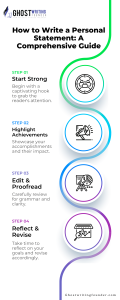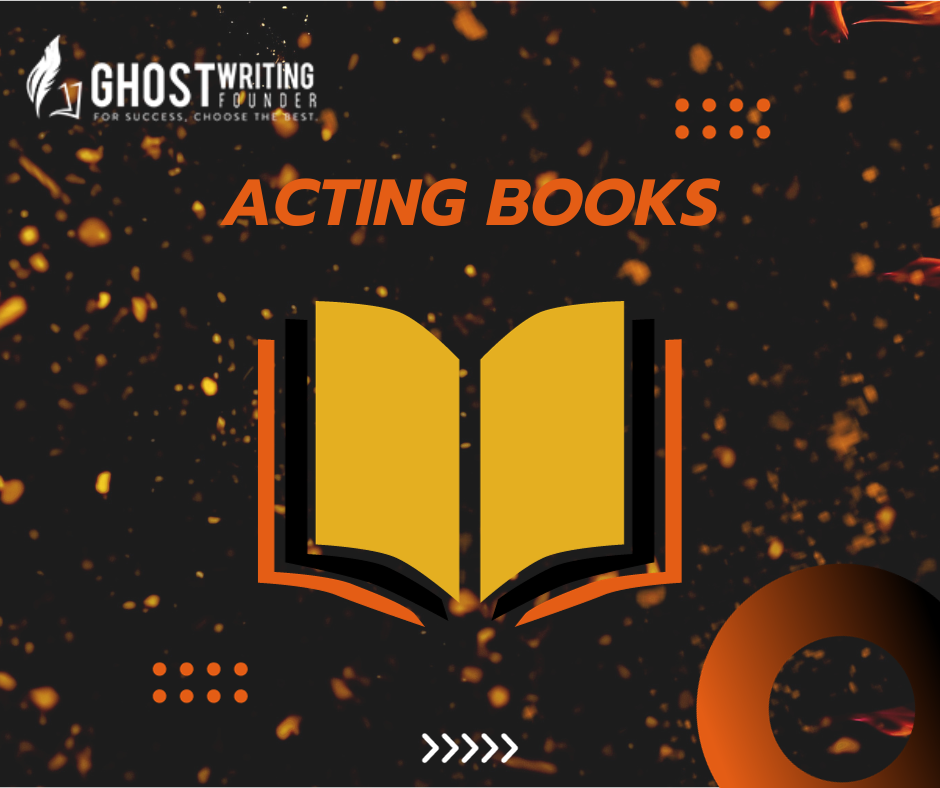
Writing
So, you’ve decided to apply for a job, a university program, or a scholarship, and you’ve encountered that dreaded “personal statement” requirement.
Don’t panic! A personal statement is your opportunity to shine, tell your unique story, and convince the decision-makers that you are the perfect candidate. In this comprehensive guide, we’ll walk you through the process to write a statement that stands out from the rest.
What is a Personal Statement?
A personal statement is like telling your story in writing, much like crafting a narrative in Fiction vs. Non-Fiction. It’s a document where you talk about yourself, your experiences, and your goals. You might need to Write a statement when you’re applying for college, a job, or a scholarship.
When you write a statement, you share what you’ve learned from your life experiences, which can be as compelling as any Autobiography vs. Biography. what makes you unique, and why you’re a great fit for the opportunity you’re applying for. It’s a chance to show your personality and convince the people making decisions that you’re the right choice.
Think of it as your way of saying, “Hey, here’s who I am, what I’ve done, and why I’m excited about this opportunity!” It helps the people reading it get to know you better beyond just looking at your grades or resume.
How to Write a Good Personal Statement?
To Write a good statement, you must be clear, concise, and well-organized. You want to ensure your writing is easy to understand so the reader can follow your story and see why you’re a perfect fit for whatever you’re applying for.
Remember, your statement is all about you, so don’t be afraid to let your personality shine through. Be honest, be yourself, and show your enthusiasm. When done right, a personal statement can help you stand out and increase your chances of getting that college acceptance, job, or scholarship you’re aiming for.

Step 1: Understand the Purpose
Before you start to Write a statement, it’s crucial to understand the purpose of your statement. Different opportunities may require different types of personal statements.
College or University Application:
The personal statement helps admissions officers get to know you beyond your grades and test scores. It’s a chance to highlight your passion for your chosen field of study and how you’ll contribute to the academic community.
Job Application:
In a job application, the personal statement demonstrates why you are a suitable candidate. It should emphasize your relevant skills, experience, and enthusiasm for the role.
Scholarship Application:
When applying for a scholarship, your statement should show why you deserve financial support. Highlight your achievements, goals, and how the scholarship will help you achieve them.
Step 2: Plan and Brainstorm
Now, the next step to Write a statement is to Identify who will be reading your statement. Tailor your writing to their expectations and interests. Admissions officers, employers, or scholarship committees will seek different qualities and qualifications.
However, before you begin writing, it’s a good idea to think about what to write in your statement. You can do this by brainstorming ideas.
Think about your life experiences, things you’ve achieved, challenges you’ve faced, and your goals for the future. Here are some questions to help you get started:
What experiences have made you who you are today?
Think about moments in your life that have greatly impacted you, similar to the life-changing events discussed in Exploring Life’s Journey: An Analysis of Autobiography in Five Short Chapters. It could be something you accomplished, a challenge you overcame, or a lesson you learned.
What are your strengths and weaknesses?
Everyone has things they’re good at and may need to work on. Think about your skills and qualities- the ones you excel in and the areas where you’re still growing.
What are your short-term and long-term goals?
Consider what you want to achieve shortly and in the years to come, and for inspiration on setting and achieving goals, read Best Non-Fiction Adventure Books Thrilling Tales of Real-Life Expeditions and Courage. Your goals can be related to your education, career, or personal growth.
How have you overcome obstacles in your life?
Life often throws challenges our way. Think about times when you faced difficulties and how you overcame them. These experiences can show your resilience, much like the stories found in Best Autobiographies of All Time: Must-Read.
What makes you different from other people?
Each person is unique, and there’s something special about you too. It could be your interests, your perspective, or your passions. Think about what sets you apart.
Step 3: Structure Your Statement
A well-structured personal statement is easier to read and more persuasive. So, if you want to Write a statement, here is a basic structure that you can follow:
Introduction
Start with a compelling opening that grabs the reader’s attention. You could use a personal anecdote, a relevant quote, or a thought-provoking question.
Clearly state the purpose of your statement and the opportunity you are applying for.
Body
This is where you provide the main content of your statement.
Use paragraphs to organize your thoughts and ideas logically. Also, highlight your achievements, experiences, and qualifications. Be specific and provide examples.
Show how your background and experiences have prepared you for the opportunity. You can also discuss your short-term and long-term goals and how the opportunity aligns with them.
Lastly, don’t forget to Explain why you are passionate about your chosen field or role. Remember to address any weaknesses or gaps in your application, but focus on how you’ve overcome or learned from them.
Conclusion
Summarize the key points you’ve made in your statement. Try to End with a strong closing statement reinforcing your suitability for the opportunity. And lastly, it leaves a lasting impression on the reader.
Step 4: Writing Tips
We understand that writing a statement that stands out can be pretty hard, but you don’t need to worry. Here are some tips you can follow if you want to Write a good statement.
Be Concise
Admissions officers and employers receive numerous applications, so brevity is key. Aim for clarity and conciseness and Avoid any unnecessary jargon or wordiness.
Be Specific
Use concrete examples to support your claims. Instead of saying you’re a “hard worker,” provide an example of a time when your hard work paid off.
Show, Don’t Tell
Don’t just tell the reader you have certain qualities; demonstrate them through your experiences and achievements. For example, instead of saying you’re “passionate,” describe a project or experience that showcases your passion.
Edit and Proofread
After writing your first draft, take a break and review and revise your personal statement. Make sure to check for grammar and spelling errors, and also Ask someone you trust to read it and provide feedback.
Step 6: Seek Feedback
Before finalizing your personal statement, seek feedback from teachers, mentors such as Ghostwriting Founder’s Memoir Writing Services, peers, or career counselors. They can provide valuable insights and suggestions for improvement.
Step 7: Finalize and Proofread
Once you’ve received feedback and made revisions, finalize your personal statement and Proofread it carefully to ensure there are no errors.
Key Characteristics and Profound Details
| Step | Key Elements | Details |
|---|---|---|
| Step 1: Understand The Purpose | – College/University Application – Job Application – Scholarship Application |
Tailor the statement to the specific context: academic, professional, or financial support. |
| Step 2: Plan And Brainstorm | – Life Experiences – Strengths & Weaknesses – Goals – Overcoming Obstacles – Unique Qualities |
Reflect on personal experiences, challenges, and aspirations to gather content for the statement. |
| Step 3: Structure Your Statement | – Introduction – Body – Conclusion |
Begin with an engaging opening, detail experiences and goals in the body, and conclude with a strong summary. |
| Step 4: Writing Tips | – Be Concise – Be Specific – Show, Don’t Tell – Edit And Proofread |
Focus on clarity, use examples, demonstrate qualities, and thoroughly revise the statement. |
| Step 5: Seek Feedback | – Teachers – Mentors – Peers – Career Counselors |
Get insights and suggestions for improvements from trusted individuals. |
| Step 6: Finalize And Proofread | – Final Revisions – Error Checking |
Make final adjustments and ensure the statement is free of grammatical and spelling errors. |
| Conclusion | – Tailoring – Conciseness – Specificity – Feedback |
Emphasize the importance of customizing the statement, being clear and precise, and incorporating feedback. |
Conclusion
Writing a personal statement can be challenging, but with careful planning and attention to detail, you can create a compelling narrative showcasing your qualifications and aspirations.
Remember to tailor your personal statement to the specific opportunity you are applying for, be concise and specific, and seek feedback to make your statement as strong as possible. Your personal statement is your chance to make a memorable impression, so make it count!









Leave a Reply